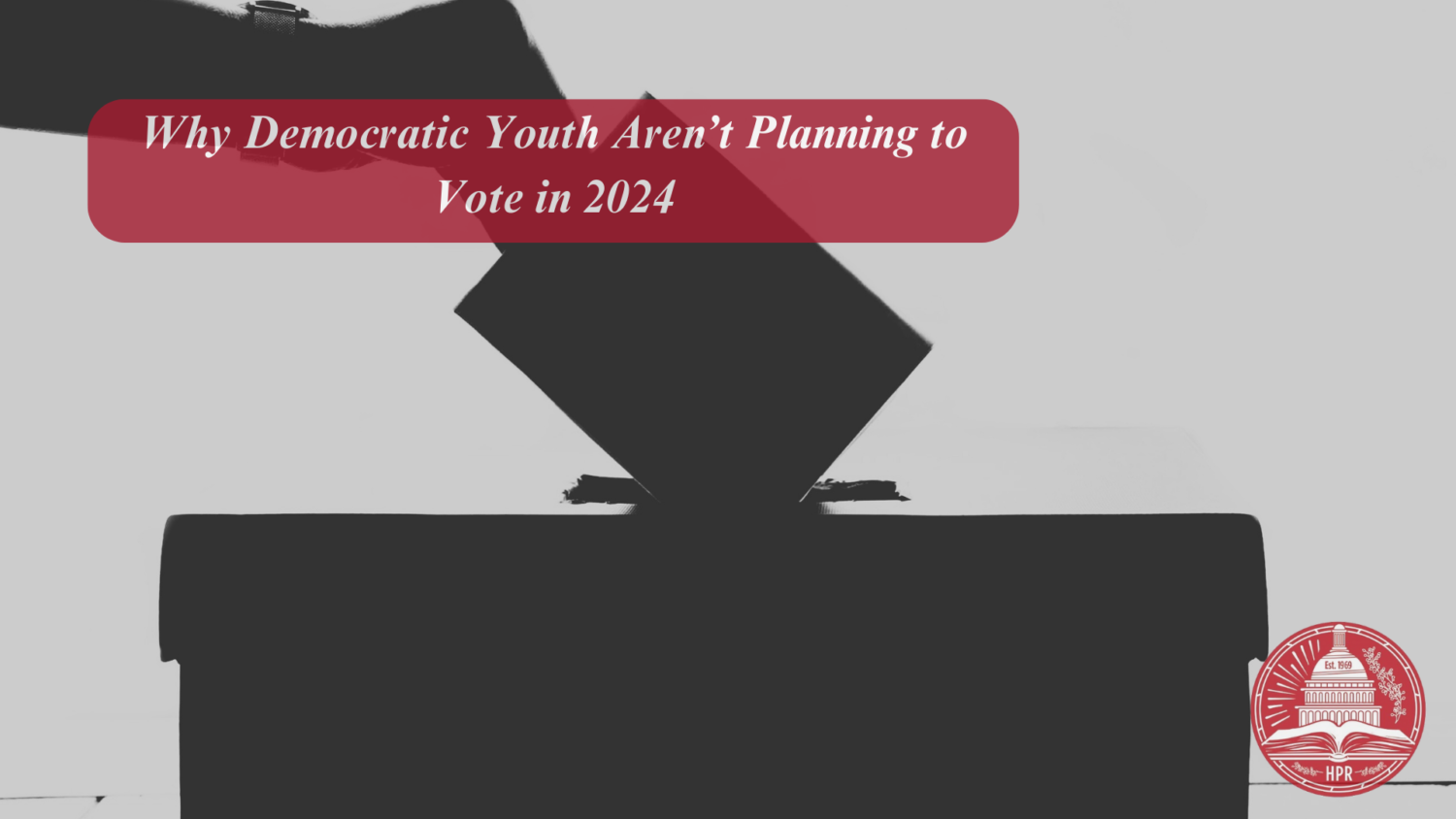The year 2024 is a watershed moment in the history of democracy and voting. An unprecedented number of nations, encompassing over half of the global population, are poised to participate in nationwide elections — the highest number in history. Yet, in a striking contrast, the United States, which celebrated its highest voter turnout of the 21st century during the 2020 presidential election, could see sharp declines in voter turnout during the 2024 presidential election.
Insights from the Harvard Public Opinion Project’s Spring 2024 Youth Poll shed light on the factors driving voter disengagement, particularly among younger, left-leaning voters. According to the poll, which surveyed a random sample of 2,010 Americans aged 18-29, only 53% stated they would definitely be voting in the election, while 21% expressed they probably or definitely would not be voting. Overall, self-indicated youth turnout thus far seems similar to the 2020 election, where 54% of youth said they would definitely vote in the Spring 2020 HPOP poll. This sentiment is similar among party lines, with 66% of Democratic youth voters and 64% of Republican youth voters definitively stating they will vote.
This trend could pose a significant challenge for the Democratic Party. The lack of intent to vote among 11% of the party’s young affiliates could be devastating if borne out in November, especially considering how crucial youth engagement was in deciding many close races during the 2022 midterms. While there is always a contingent of eligible youth voters who do not turn out, the ideological makeup of this group could have important implications for how Democrats adjust their messaging and tactics in the lead-up to November.
A commonly purported belief about the predicted poor youth turnout is that those with progressive economic views who align closely with Democratic Socialists, such as Senator Bernie Sanders, are more likely to not turn out for the 2024 election. This view results from the Democrats’ inability to make good on many of their campaign promises, leading to a growing sense of disillusionment and skepticism among voters, particularly the youth, who were initially motivated by a progressive agenda but now feel let down by the lack of tangible progress. However, contrasting evidence from the HPOP’s polling data suggests this effect is not as prevalent as is popularly believed.
Among Democrats who affirm that “Basic health insurance is a right for all people, and the government should provide it if someone cannot pay,” only 4% are certain they will not vote. This figure is nearly one percentage point lower than the overall average for young Democrats. Conversely, 14% of Democrats who oppose this view assert they definitely will not vote, a substantial increase of nearly 10 percentage points. While recognizing health insurance as a universal right is a mainstream stance among Democratic voters, the Democrats’ failure to pass healthcare reform has not resulted in decreased voter turnout among its advocates.
This pattern persists in views on government spending aimed at reducing poverty. Approximately 12% of Democrats who disagree with the statement that “The Government should spend more to reduce poverty” express a definite intention not to vote. Contrastingly, there’s a slight decrease in the non-voting percentage among Democrats who agree with this statement.
Furthermore, the data reveals a similar dynamic regarding tax cuts and economic growth. Among Democrats who disagree with the statement “Cutting taxes is an effective way to enhance economic growth,” only 1% state they are definitely not voting. However, this figure rises to 7% among those who agree. These disparities suggest a higher likelihood of electoral abstention among Democrats holding fiscally conservative views, contrary to popular belief.
The influence of other issues, such as immigration and climate change, appears to be less decisive in determining Democratic youth voter turnout. Irrespective of their stance on “The Government should do more to curb climate change,” fewer than 5% of Democratic youths are certain they will not vote, indicating that climate policy might not be a primary factor in voter disengagement. Similarly, attitudes toward the question “Recent immigration into this country has done more harm than good” have minimal impact on the voting decisions of young Democrats, irrespective of whether they view immigration as beneficial or harmful.
Although this data isn’t conclusive, it illuminates that voters disenchanted by the Democrats’ lack of legislative success in economic policy may not be the primary contingent of Democratic youth voters who are likely to abstain from voting in 2024. For the Biden campaign, these trends could be an excellent omen for the upcoming election. Reflecting on previous elections, especially the 2016 presidential race, it’s clear that the diminished turnout among progressive voters played a significant role in the Democratic Party’s losses. In 2024, the threat of a second Trump term might be enough to galvanize voters currently disappointed with Democrats’s lack of economic policy reform, ensuring they still show up for the Democratic Party on Election Day.
As a result, even though fiscally conservative young Democrats are more likely to abstain from voting, it may not be wise for Biden to alter his messaging to cater to more moderate voters. He should focus on strengthening his existing base since altering his position could risk alienating his dedicated supporters without ensuring the support of more centrist voters. Biden cannot take the progressive vote for granted. Instead, he should capitalize on his opponent’s extreme unpopularity amongst moderate voters of both parties to attract swing voters. Painting Trump as a dictatorial figure might persuade moderate Democrats who are uneasy about Biden’s policies to view him as the lesser of two evils and vote for him in November.
Overall, despite young Democrats’ disappointment over unfulfilled promises, many of these voters will continue to turn out for the Democratic Party, hoping for change and progress in the future.
Associate U.S. Editor




